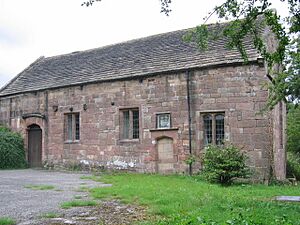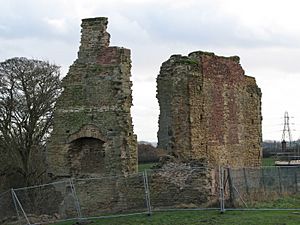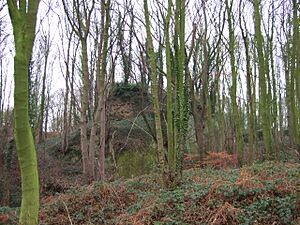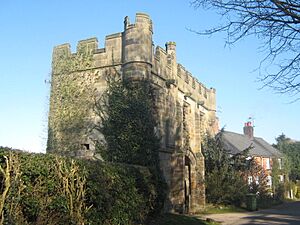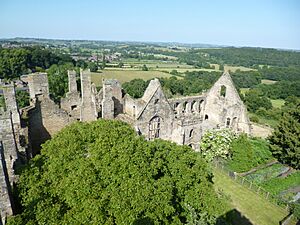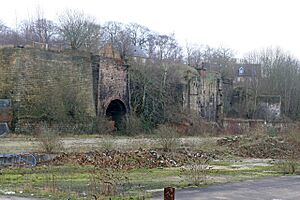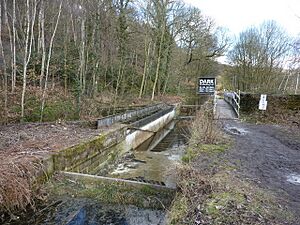Scheduled monuments in Amber Valley facts for kids
A scheduled monument is a special historic place or building in the United Kingdom. It's considered "nationally important" because of its history or archaeology. These places are protected by law, meaning no one can change them without permission. This protection helps keep them safe for future generations to learn from and enjoy. English Heritage helps decide which sites get this special status. There are about 20,000 scheduled monuments across the UK, including ancient settlements, old bridges, and even old industrial sites.
Sometimes, a scheduled monument can also be a "listed building." This means it's important for its architecture or history. However, English Heritage usually thinks being a listed building offers better protection for buildings than being a scheduled monument. If a place is no longer considered important enough, it can be removed from the list.
Derbyshire, the county where Amber Valley is located, has over 500 scheduled monuments. These include many ancient stone piles called cairns, stone circles, old burial mounds called barrows, remains from lead mining, and more than 20 bridges.
Contents
What Are Amber Valley's Scheduled Monuments?
Amber Valley is home to several fascinating scheduled monuments. These sites tell us stories about the past, from ancient times to the industrial revolution. Let's explore some of them!
Ancient Chapels and Castles
Alderwasley Chapel: A Historic Church
Alderwasley Chapel is a very old chapel built in the early 1500s. It was built by Thomas Lowe, who was the Lord of the Manor at the time. For many years, people in Alderwasley used this chapel for church services. However, around 1850, a new church was built, and services moved there. Today, the chapel is also a Grade II listed building, meaning it's recognized for its special historical and architectural importance.
Codnor Castle: A Ruined Fortress
Codnor Castle is a ruined castle from the 13th century. It stands near Codnor and Ripley. Even though it's mostly ruins now, you can still imagine what this strong fortress looked like centuries ago. Castles like Codnor were important for defense and as homes for powerful families in medieval times.
Horsley Castle: A Tower Keep
Horsley Castle is another historic castle in Amber Valley. It features a "tower keep," which was the strongest and most protected part of a medieval castle. These towers often served as the main living area and last defense point.
Mackworth Castle Gatehouse: Part of a Medieval Home
Mackworth Castle was a large home built in the 14th or 15th century. It was the home of the Mackworth family for hundreds of years. Today, only the gatehouse remains. This gatehouse is a Grade I listed building, which means it's considered very important historically. The site also includes parts of the old medieval village and its farming fields.
Wingfield Manor: A Grand Medieval House
Wingfield Manor is a huge medieval house that started being built in 1441. It was built for Sir Ralph Cromwell, who was an important official for King Henry VI. The manor has been deserted since the 1770s, but its impressive ruins still stand. It's also a Grade I listed building, showing its great historical value.
Old Settlements and Roads
Castle Hill Camp: An Ancient Settlement
Castle Hill camp is an ancient settlement located in South Wingfield. These "camps" were often fortified places where people lived many centuries ago, sometimes even before castles were built.
Mugginton Medieval Settlement: A Glimpse into Village Life
The Mugginton medieval settlement in Weston Underwood includes parts of an old "open field system." This was a common way of farming in medieval times, where large fields were divided into strips for different families to grow crops. This site helps us understand how people lived and farmed long ago.
Roman Roads: Paths from the Past
Amber Valley has sections of two very old Roman roads.
- One section is in Kirk Langley, northeast of Moor Lane.
- Another section is part of a famous Roman road called Rykneld Street, found south of Ticknall Hill in Denby.
These roads were built by the Romans thousands of years ago and were important for travel and trade across Britain.
Industrial Heritage: Mines and Mills
Butterley Works Blast Furnace Complex: An Industrial Giant
The Butterley Works blast furnace complex near Ripley dates back to the 1790s. Blast furnaces were huge structures used to make iron, which was a key material during the Industrial Revolution. This site also includes a canal tunnel and an underground wharf, showing how important waterways were for transporting goods.
Morley Park Works: Another Metalworking Site
Morley Park Works in Ripley was another important metalworking site. These industrial sites are scheduled monuments because they show us how Britain became a leading industrial nation.
Unique Engineering: Aqueducts and Tunnels
Cromford Canal Aqueduct: Water Over Rail
This aqueduct in Dethick, Lea and Holloway is a clever piece of engineering. It carries the Cromford Canal over the Derby to Matlock railway line. Aqueducts are like bridges for water, allowing canals to cross valleys or other obstacles.
Fritchley Tunnel: The World's Oldest Railway Tunnel?
Fritchley Tunnel in Crich is a disused railway tunnel. It was built in 1793 by Benjamin Outram as part of the Butterley Gangroad. Many people believe this tunnel is the oldest surviving railway tunnel in the world! It's a fantastic example of early railway engineering.
Moated Sites: Protected Homes
Several "moated sites" are scheduled monuments in Amber Valley. These were homes or settlements surrounded by a ditch filled with water, like a small castle moat. They were built for defense and to show off wealth.
- Moated site in Mapperley Park Wood
- Moated site north of Dannah Farm in Shottle and Postern
- Park Hall moated site, well and enclosure in Mapperley
- Windley Moated Manorial Complex at Farnah Hall, Windley
These sites give us clues about how people lived and protected themselves centuries ago.


